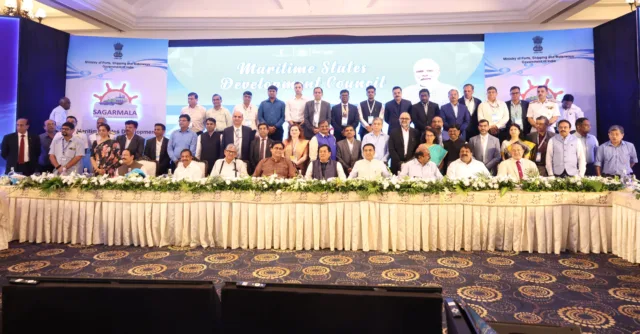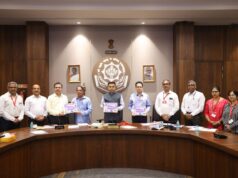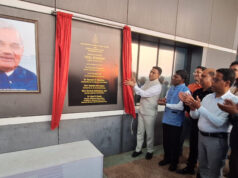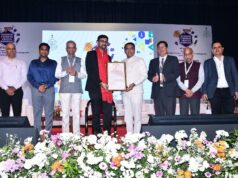The 20th Maritime State Development Council (MSDC), Goa concluded today with remarkable outcomes for India’s maritime sector. This two-day event saw the resolution of over 80 critical issues between the Central Government, States, and Union Territories, focussed on port infrastructure modernisation, connectivity, statutory compliances, maritime tourism, navigation projects, sustainability, and port security.
During the 20th MSDC, over 100 issues from various states were deliberated and successfully resolved. Several new and emerging challenges were also addressed, including the establishment of Places of Refuge (PoR) for ships in distress, the development of Radioactive Detection Equipment (RDE) infrastructure at ports to enhance security, and the facilitation of seafarers by recognising them as key essential workers, ensuring better working conditions and access to shore leave. Additionally, the meeting discussed the implementation of a State Ranking Framework and a Port Ranking System to foster healthy competition and drive performance improvements across India’s maritime sector.
The meeting was graced by the Union Minister of Port Shipping and Waterways, Sarbananda Sonowal; MoS, MoPSW, Shantanu Thakur; Minister of Captain of Ports, Government of Goa; Aleixo Sequeira; Devendra Kumar Joshi, LG, Andaman & Nicobar; Mankala S Vaidya, Minister of Fisheries, Ports, and Inland Water Transport, Government of Karnataka; Thiru E.V. Velu, PWD Minister, Tamil Nadu; Shri TK Ramachandran, Secretary, MoPSW and various other dignitaries.
Union Minister of Ports, Shipping and Waterways, Sarbananda Sonowal, emphasised the significance of MSDC’s contribution, ‘The MSDC has been instrumental in aligning policies and initiatives like the Indian Ports Bill and the Sagarmala program. By resolving key issues between the Central Government, states, and maritime boards, the Council has ensured the seamless development of India’s maritime infrastructure, enabling coastal states to capitalize on emerging opportunities.The MSDC’s efforts over the past two decades have facilitated the growth of over 50 non-major ports, which now handle more than 50% of India’s annual cargo. As major ports approach saturation, these non-major ports will play a crucial role in the future of India’s maritime sector’.
‘Under the leadership of PM Modi the Indian Maritime sector is growing like never before. Recently, PM Narendra Modi laid the foundation stone of India’s 13th Major Port worth Rs 76,220 crores at Vadhavan in Maharashtra 30th August 2024. The government has also designated Galathea Bay in the Andaman & Nicobar Islands as a ‘Major Port’. This Rs 44,000 crore project will be developed under a public-private partnership model and aims to capture transshipped cargo currently handled outside India. The first phase is expected to be operational by 2029’, added Shri Sonowal.
The Sagarmala program, approved by the Union Cabinet in 2015, envisions a total of 839 projects with an estimated investment of Rs 5.79 lakh crore, slated for completion by 2035. Out of these, 262 projects, amounting to approximately Rs 1.40 lakh crore, have already been completed, while another 217 projects, valued at around Rs 1.65 lakh crore, are currently under active implementation. These projects span multiple sectors and involve the coordinated efforts of central ministries, state governments, major ports, and various other agencies, reflecting a comprehensive approach to transforming India’s maritime infrastructure.
‘India’s maritime sector stands at a pivotal moment of transformation. Through the initiatives launched at the MSDC, we are not only advancing infrastructure and safety but also creating an environment that encourages innovation, collaboration, and growth. The inclusion of digital platforms and enhanced ease of doing business initiatives are key steps in making India a leader in global maritime trade. The future of India’s maritime landscape is bright’, said Shantanu Thakur, Minister of State for Ports, Shipping, and Waterways.
In a major initiative to further improve the ease of doing business in the maritime sector, the MSDC launched the National Safety in Ports Committee (NSPC) application on the National Single Window System platform. This application will streamline regulatory processes, improving efficiency and reducing costs for stakeholders. The platform allows for real-time performance monitoring, which will significantly enhance the operational efficiency of various departments through well-coordinated information sharing.
The plans for a Mega Shipbuilding Park, spanning multiple states, were discussed during the Maritime State Development Council (MSDC) meeting. This ambitious initiative aims to consolidate shipbuilding capabilities across regions, fostering greater efficiency and innovation. By integrating resources and expertise from various states, the park is set to become a key hub for the maritime sector, driving growth and reinforcing India’s position on the global shipbuilding stage.
Additionally, the launch of the Indian International Maritime Dispute Resolution Centre (IIMDRC) marks a significant milestone. This specialized platform will offer merit-based and industry-governed solutions to resolve maritime disputes efficiently, addressing the multi-modal, multi-contract, multi-jurisdictional, and multi-national nature of maritime transactions. IIMDRC positions India as a global hub for arbitration, aligning with the “Resolve in India” initiative.
Another noteworthy launch was the Indian Maritime Centre (IMC), a Policy Think Tank designed to bring together maritime stakeholders currently operating in silos. IMC will foster innovation, knowledge sharing, and strategic planning, driving growth and development across India’s maritime sector.
A historic highlight of the event was the keel laying ceremony for India’s largest dredger, a 12,000 Cu. M. Trailer Suction Hopper Dredger (TSHD), at Cochin Shipyard Limited, built in collaboration with IHC Holland. This is the first time a dredger of such magnitude is being constructed in India, marking a monumental achievement for the country’s maritime infrastructure.
Several maritime boards presented cutting-edge innovations during the MSDC. The Kerala Maritime Board showcased its innovative techniques for monetizing dredging efforts, while the Gujarat Maritime Board shared a case study on port-driven urban development initiatives. The Andhra Pradesh Maritime Board presented a comprehensive maritime development masterplan, and the Indian Coast Guard demonstrated a successful case study on the Maersk Frankfurt Fire rescue operation.
The Council also discussed the State Ranking Framework, which aims to promote healthy competition, performance enhancement, and sustainable practices among coastal states. A working group will be established to determine the parameters and weightage for evaluating and ranking states based on key maritime and regulatory metrics.
Sonowal also shed light on the National Maritime Heritage Complex (NMHC) at Lothal, Gujarat, which will serve as an international tourist destination, showcasing India’s rich maritime heritage through advanced technology. The NMHC will see international collaborations with 25 countries, with signed MoUs from Portugal, UAE, and Vietnam, and MoU signings with France, Norway, Iran, and Myanmar in advanced stages. Maharashtra and Gujarat have already developed their state pavilions for NMHC, and coastal states are encouraged to participate and showcase their maritime heritage.
The 20th MSDC meeting has set a strong agenda for the future, ensuring that India’s maritime sector continues to grow, contributing significantly to the nation’s economy and solidifying its position in the global maritime landscape.
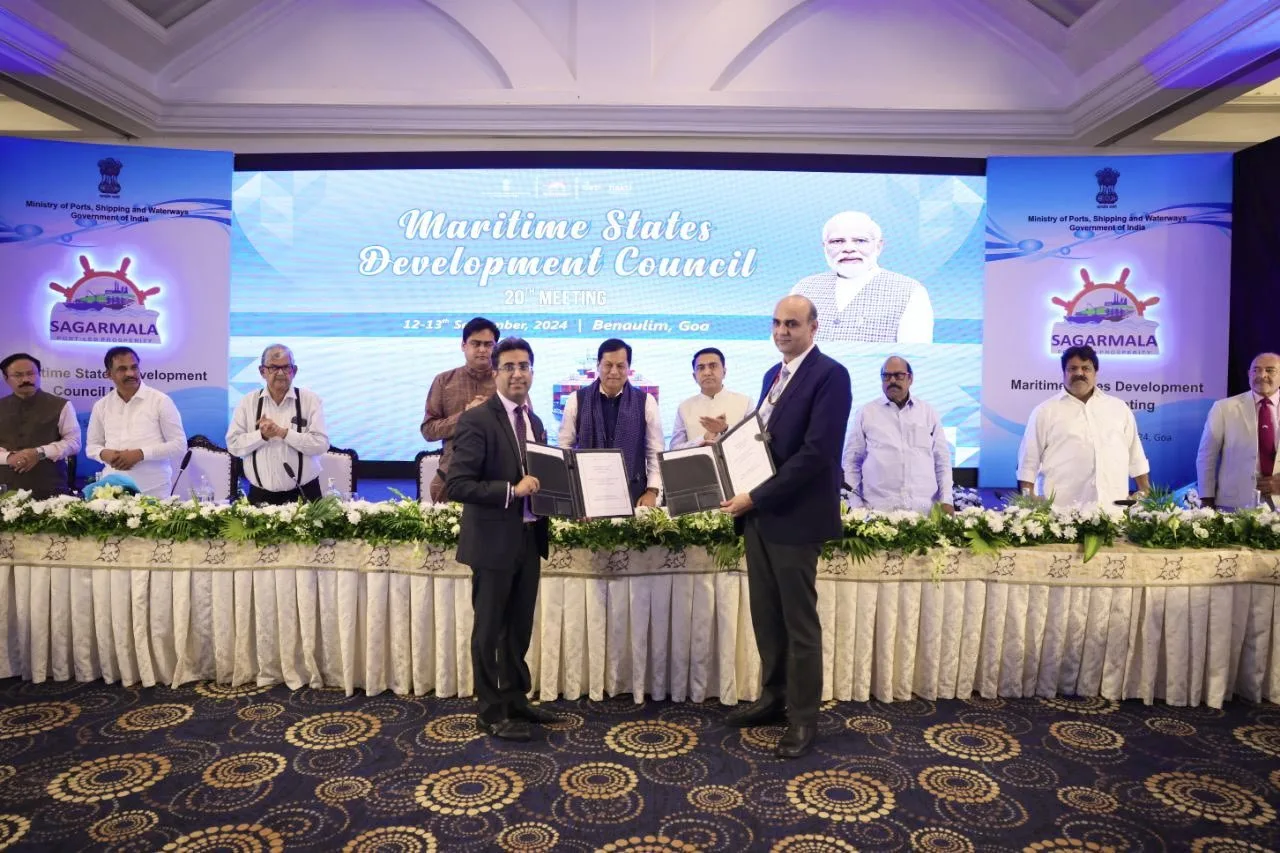
Chief Minister Dr Pramod Sawant also attended and addressed the 20th Maritime States Development Committee Meeting.
In his address, Dr Sawant emphasised on several key areas for future focus: Coastal Community Development, Port-Led Industrialisation, Sustainable Marine Ecosystem Protection, and the implementation of Digital and Smart Port solutions.


